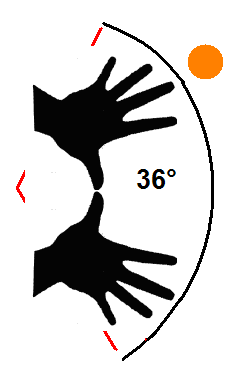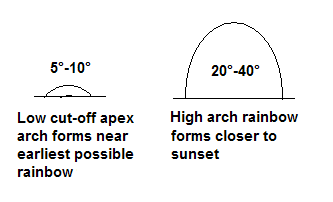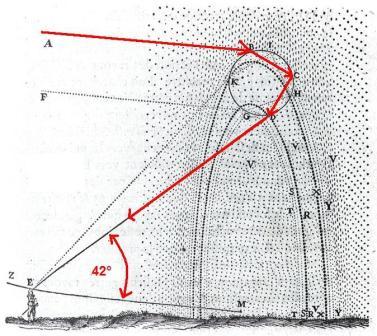Spring 2008 Rainbow Hunting Calendar - Salt Lake City - March to May
Rev. 3-4-2008 Orig. 3-2-2008
This emphemeris table approximates times in the afternoon when the first solar angle that might produce rainbows begins during the rainy spring season in Salt Lake City, Utah - the months of March, April and May. (It also intended to provide a template for local astronomy clubs to produce similar rainbow sighting calendars for their region.) Rainbows might be seen at any time after the time listed in the left-hand column of the table through sunset between the directions indicated in the columns containing the label "RainbowBearingAz" (columns three and ten). The best time to see a large rainbow is about one to one and one-half hours before sunset (column five). Further explanatory notes on the table's use follows the table.
Table 1. Spring 2008 Rainbow Observing Opportunity Calendar - Salt Lake City
Sort order: Month, Day
Smallest
possible rainbows
begining at | | First possible | | Largest possible rainbows
beginning at | | Recommended | | | Sunset | |
| Date_Time_Local | SunAz | Rainbow
BearingAz | SunAlt | Recommended
time | SunAz | Rainbow BearingAz | Time of sunset | SunAz at sunset | Rainbow BearingAz | SunAlt at sunset |
| 03/01/2008 14:00:00 | 205 | 25 | 38 | 16:49 | 245 | 65 | 18:19 | 261 | 81 | 0 |
| 03/07/2008 14:00:00 MST | 207 | 27 | 40 | 16:56 | 249 | 69 | 18:26 | 264 | 84 | 0 |
| 03/13/2008 15:00:00 MDT | 208 | 28 | 42 | 18:03 | 252 | 72 | 19:33 | 267 | 87 | 0 |
| 03/24/2008 16:00:00 | 230 | 50 | 38 | 18:14 | 258 | 78 | 19:44 | 273 | 93 | 0 |
| 04/01/2008 16:00:00 | 233 | 53 | 41 | 18:23 | 262 | 82 | 19:53 | 277 | 97 | 0 |
| 04/07/2008 16:00:00 | 235 | 55 | 42 | 18:29 | 265 | 85 | 19:59 | 280 | 100 | 0 |
| 04/14/2008 16:15:00 | 240 | 60 | 42 | 18:36 | 269 | 89 | 20:06 | 284 | 104 | 0 |
| 04/30/2008 16:30:00 | 251 | 71 | 42 | 18:53 | 276 | 96 | 20:23 | 291 | 111 | 0 |
| 05/08/2008 17:00:00 | 259 | 79 | 38 | 19:02 | 279 | 99 | 20:32 | 294 | 114 | 0 |
| 05/14/2008 17:00:00 | 261 | 81 | 39 | 19:07 | 281 | 100 | 20:37 | 296 | 116 | 0 |
| 05/21/2008 17:00:00 | 262 | 82 | 40 | 19:14 | 284 | 104 | 20:44 | 298 | 118 | 0 |
| 05/27/2008 17:00:00 | 263 | 83 | 40 | 19:19 | 285 | 105 | 20:49 | 300 | 120 | 0 |
Explanatory notes
|
The Sun must be lower than 42°s altitude to produce a rainbow. At the time indicated in the left-hand column, only a small arc - essentially the cut-off apex of a full rainbow would be seen - only maybe three to seven degrees high. As the Sun approaches sunset, the angular size of the rainbow arc grows to a maximum possible of 42°s high - just as the sun sets. The smallest visible rainbow will occur within the hour after the time listed in the left-hand column below. The largest practically possible rainbow can occur about an hour before sunset listed in the fifth column. Rainbows might be seen between those times and between the azimuth directions listed in third and tenth columns.
Two hands held outstretched with the fingers spread apart, measure about 36 angular degrees. Align your bottom finger on the horizon. If the Sun is lower than your highest finger, rainbows can form.
|

Figure 1 - Using your hands to measure whether the Sun is low enough to form a rainbow
|
|
A large rainbow will cover 80 arc degrees and its apex will be between 10 and 40° above the ground. Its apparent position will be one to several kilometers distant.
A smallest visible rainbow appears a short distance away (one or two blocks), is about 12 degs wide, is almost directly touching the ground on its base, and appears as a truncated apex of a normal large rainbow. Such rainbows occur when the Sun is just below the altitude at which rainbows can first form.
|

Figure 2 - Low apex arch early in day and high arch near sunset
|
The column "SunAz" means the azimuth in degrees proceeding clockwise from true north. This is the direction of the Sun, usually in the southwest sky, at the indicated time. Due south is 180°s azimuth. Due west is 275° azimuth.
The column "RainbowBearingAz" means the bearing 180° away from the Sun's azimuth. This is the general direction in which a rainbow can be expected to form - at the anti-solar point (the point opposite the Sun's position in the sky). At the indicated time, look in the direction listed, generally northeast early in March and due east in May.
A good viewing time is midway between the first visible rainbow and sunset through sunset. My personal favorite time is about one and one-half hours before sunset - listed in the fifth column.
The spring is a good time for rainbow hunting in Salt Lake City because of the interaction between weather and the Wasatch Mountains. Rain storms come from the west off the Pacific Ocean and are blocked by and pile up against the north-south trending Wasatch Mountains. This creates a band of light rain sheets along the east bench of the Salt Lake Valley. The western sky can be partly cloudy or clear, while the eastern sky is under a cloud deck. When the Sun is low in the southwest sky, the Sun streams under the eastern cloud deck and strikes rain sheets. These are favorable conditions for the formation of rainbows.
|
For a visible rainbow to form, both a favorable solar angle and favorable weather conditions are needed. During the spring, look for rainbows when there rain sheets can be seen along the east bench but the western sky is either partly cloudy or clear.
Another special time to see rainbows in Salt Lake is around Christmas and the winter solistice between noon and 1:00pm. At the winter solistice near noon, the Sun is due south at an altitude of 23 1/2°. On winter days after storms where there is alot of residual mositure in the air, between the second week of December and the first week of January, good rainbows can form due north around noon. These "Christmas rainbows" are also listed on Figure 4.
In the 1600s, the great French naturalist and mathematician Descartes explained how rainbows form. Each raindrop in a sheet of falling water droplets is a small sphere. The light from the Sun passes over the observer's head and into the droplet-sphere. The light is refracted two twice and reflected twice off by the inside of the water droplet sphere. By these refractions and reflections, the light reverses direction. The sunlight exits out the front of the droplet at a characteristic angle relative to the observer and ground of about 42°.
|

Figure 5 - Descartes' explanation of a rainbow
|
K. Fisher fisherka@csolutions.net Rev. 3-4/2008 Orig. 3-2-2008
Released to public domain. No copyright asserted. Reproduce freely.
